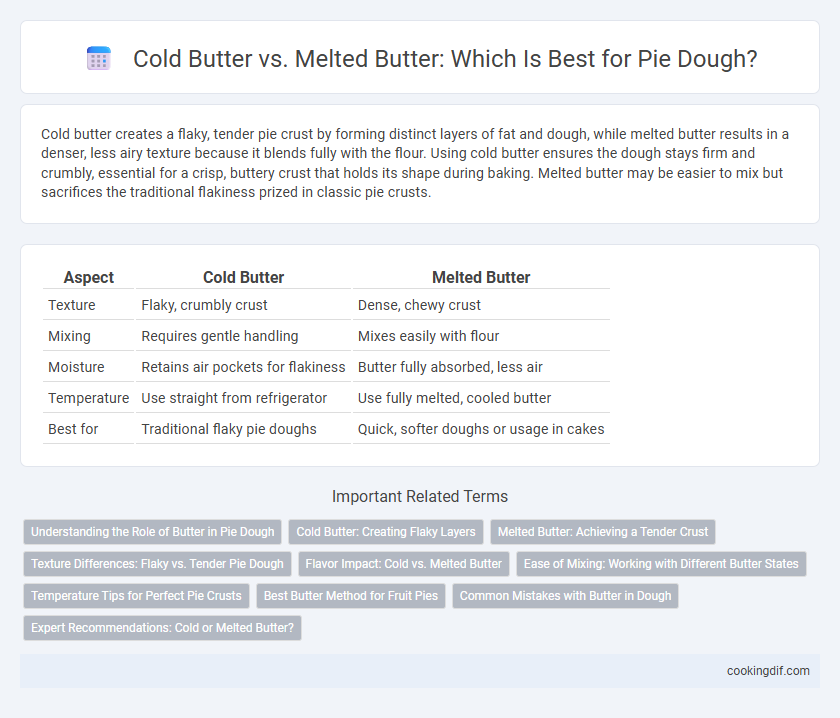Cold butter creates a flaky, tender pie crust by forming distinct layers of fat and dough, while melted butter results in a denser, less airy texture because it blends fully with the flour. Using cold butter ensures the dough stays firm and crumbly, essential for a crisp, buttery crust that holds its shape during baking. Melted butter may be easier to mix but sacrifices the traditional flakiness prized in classic pie crusts.
Table of Comparison
| Aspect | Cold Butter | Melted Butter |
|---|---|---|
| Texture | Flaky, crumbly crust | Dense, chewy crust |
| Mixing | Requires gentle handling | Mixes easily with flour |
| Moisture | Retains air pockets for flakiness | Butter fully absorbed, less air |
| Temperature | Use straight from refrigerator | Use fully melted, cooled butter |
| Best for | Traditional flaky pie doughs | Quick, softer doughs or usage in cakes |
Understanding the Role of Butter in Pie Dough
Cold butter creates flaky pie dough by forming distinct layers as it melts during baking, while melted butter yields a denser, less tender crust due to even fat distribution. The temperature and state of butter directly influence gluten development and texture in pie dough. Proper handling of cold butter prevents overworking the dough, ensuring optimal flakiness and a delicate crumb.
Cold Butter: Creating Flaky Layers
Cold butter is essential for creating flaky layers in pie dough by maintaining small, solid fat pockets that steam during baking, producing lift and separation in the crust. Keeping butter cold prevents it from fully blending with flour, allowing distinct layers to form and resulting in a tender yet crisp texture. Using chilled butter combined with minimal handling preserves these layers, enhancing the pie's flaky and buttery quality.
Melted Butter: Achieving a Tender Crust
Melted butter in pie dough enhances tenderness by fully coating flour proteins, reducing gluten development and resulting in a softer, more delicate crust. This method also imparts richer flavor and improved moisture retention, crucial for flaky pie textures. Optimal temperature control during mixing prevents butter from over-saturating the dough, ensuring balance between pliability and structure.
Texture Differences: Flaky vs. Tender Pie Dough
Cold butter creates flaky pie dough by maintaining solid fat pockets that release steam during baking, producing distinct layers. Melted butter blends fully into the dough, resulting in a tender, less layered texture with a softer bite. Choosing between cold and melted butter directly impacts the pie crust's final mouthfeel and structural integrity.
Flavor Impact: Cold vs. Melted Butter
Cold butter in dough creates distinct, flaky layers that enhance texture and provide a rich, buttery flavor, while melted butter integrates fully, resulting in a denser crust with a more uniform taste. The temperature of butter directly influences gluten development and moisture distribution, affecting pie crust flakiness and flavor depth. Using cold butter preserves air pockets during baking, intensifying the buttery aroma and creating a superior flavor profile compared to melted butter.
Ease of Mixing: Working with Different Butter States
Cold butter creates a crumbly texture in dough, making it easier to mix without overworking, which is essential for flaky pie crusts. Melted butter blends smoothly, resulting in a softer dough but requires careful handling to prevent toughness. Choosing between cold and melted butter affects dough consistency and ease of mixing, influencing the final pie crust texture.
Temperature Tips for Perfect Pie Crusts
Cold butter is essential for creating flaky pie crusts because it stays solid during mixing, forming small pockets of fat that create layers when baked. Melted butter, on the other hand, can result in a dense and greasy crust due to fat absorption by the flour before baking. Maintaining a chilled dough temperature below 70degF ensures optimal texture and prevents butter from melting prematurely, enhancing crust flakiness and crispness.
Best Butter Method for Fruit Pies
Cold butter is essential for creating flaky, tender pie crusts as it melts slowly in the oven, forming pockets of steam that contribute to the dough's light texture. Melted butter, while easier to mix, can result in denser, greasy crusts lacking the desired flakiness critical for fruit pies. For optimal fruit pie dough, using cold butter and incorporating it in small, chilled pieces or grated ensures a crisp, airy crust that balances the pie's juicy filling perfectly.
Common Mistakes with Butter in Dough
Cold butter in dough helps create flaky layers by remaining solid and releasing steam during baking, while melted butter often leads to denser, less tender crusts. A common mistake is using melted butter when a flaky texture is desired, causing the dough to lack structure and crumble easily. Ensuring butter is properly chilled and cut into small pieces prevents overworking the dough and results in a perfect pie crust.
Expert Recommendations: Cold or Melted Butter?
Expert recommendations for pie dough frequently favor cold butter over melted butter to achieve a flaky and tender crust. Cold butter creates small pockets of steam during baking, which results in a light, flaky texture, while melted butter tends to produce a denser, less flaky crust. Techniques such as cutting cold butter into the flour or using chilled cubes ensure optimal dough consistency and superior pie crust quality.
Cold butter vs melted butter for dough making Infographic

 cookingdif.com
cookingdif.com